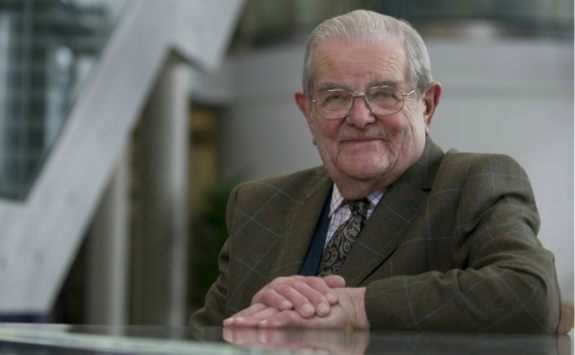Take a tour of the great and good celebrated on campus
Ahead of the new academic year starting, we explored the buildings on campus honouring esteemed figures in our university’s history.
3 September 2025
How many of these celebrated figures are you aware of?
Barbara Strang Teaching Centre
The Barbara Strang Teaching Centre opened in 2014 and is based within the Bedson Building. It is named in recognition of the university’s first Chair of English Language and General Linguistics and globally recognised linguist, Lady Barbara Strang (1925 – 1982).
This was the first chair of its kind in England, established in 1964, and Lady Strang was one of the first women to hold such a post. Under her leadership, the new department established an international reputation.
Lady Strang’s research expertise was wide-ranging, extending from reviews on the acquisition of language in developmental medicine and child neurology to the history of the Kentish dialect. She established her name when her first publication Modern English Structure in 1962 became a standard work, and eight years later she published A History of English. Lady Strang was also the driving force behind the Tyneside Linguistic Survey which became the backbone of the digital twenty-first century DECTE corpus, allowing her legacy to live on in ways that she herself could never have predicted.
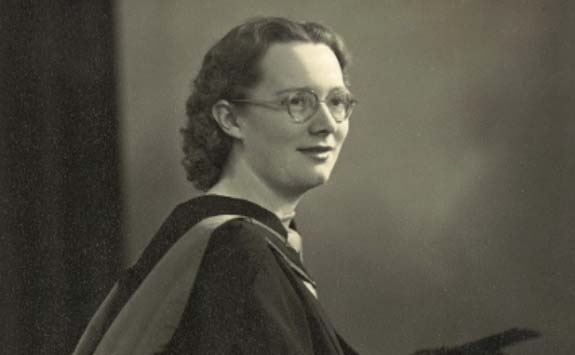
Bedson Building
The Bedson building, home to the university’s Chemistry department, is named after former Head of Chemistry at King’s College Durham, Professor Peter Bedson (1853-1943). Professor Bedson arrived on campus in 1882 as a lecturer, rising to the position of Head of department before his retirement in 1921.
It is for his work on coal that Professor Bedson is best known, having transitioned from pure chemistry to devote his talents to the major chemical industries of Tyneside upon arriving in Newcastle. Professor Bedson explored the extraction and analysis of the gases occluded in coal dust with the aim of reducing the danger arising from its combustion. He also collaborated with Sir Thomas Oliver to study lead poisoning in those engaged in the making of white lead.
Alongside this humanitarian research and his teaching commitments, Professor Bedson also translated Lothar Meyer’s ‘Modern Theories of Chemistry’ in collaboration with W. Carleton Williams.
Construction of the building was due to begin in 1939, however the outbreak of the Second World War saw plans grind to a sudden halt. Permission to begin work was finally granted in 1946 and two new Chemistry Department wings were opened in December 1949. These new additions were five storeys high to accommodate the further rise in student intake, over treble what it had been ten years earlier.

Cassie Building
The Cassie Building was built in 1955 and is named after William Fisher Cassie (1905-1985), who was Professor of Civil Engineering at King’s College Durham (subsequently Newcastle University) between 1943 and 1970. The building is still home to the Civil Engineering department today.
Professor Cassie was a noteworthy author on building structure. He was an expert on soil mechanics and a strong advocate of underground transport systems. In 1965, he was appointed Deputy Chairman of the Advisory Council on Road Research under Prof F.E.Jones.
Professor Cassie was also a noted collector of the traditional dances of North East England and the Rapper Sword tradition in particular. He was instrumental in starting the Newcastle Kingsmen Sword Team in 1949, who continue to be associated with Newcastle University.
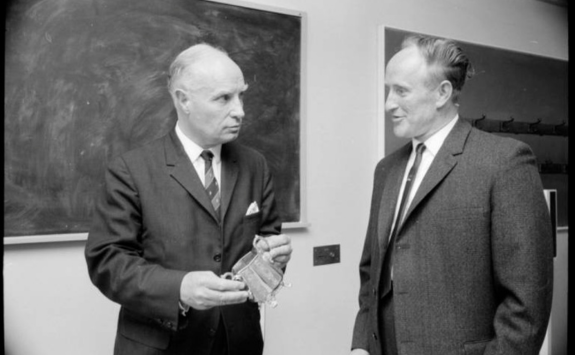
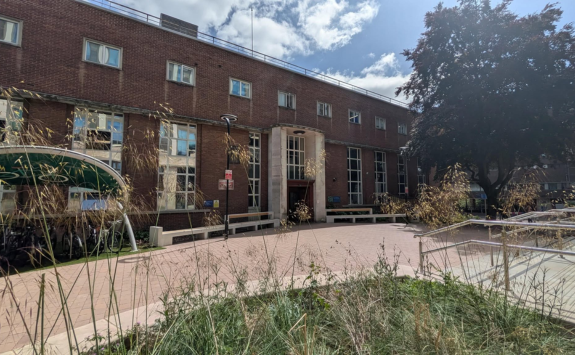
Elizabeth Barraclough Building
The Elizabeth Barraclough Building (formerly Black Horse House) has been owned by the university since circa 2014 and was renamed in 2019 in honour of Elizabeth Barraclough, a former Director of the University Computing Service (UCS). The building is home to Newcastle University’s IT Service.
She came to work at the University in 1957 (at that time King's College), as a computer operator for the vacuum-tube-based Ferranti Pegasus computer - the very first computer at the university! Barraclough spent three months in the USA implementing a medical information system in 1963, now considered to be one of the world’s first electronic databases. She was awarded a Master’s degree in computing in 1964 for work on school timetables and sent her first e-mail via the ARPA network in 1969.
Barraclough was Director of UCS at a time of rapid technological development, and retired from that role in 1993, going on to live in Keswick and became a local councillor and later Mayor. She was awarded an honorary fellowship from Newcastle University in 2006.

Farrell Centre
Instigated by renowned architect-planner and Newcastle alumnus Sir Terry Farrell, and forming part of our School of Architecture, Planning and Landscape, the Farrell Centre opened in 2023 and widens the debate around the crucial roles that architecture and planning play in the contemporary world in ways that are innovative, engaging and challenging.
Sir Terry grew up in Newcastle upon Tyne and studied Architecture at Newcastle University between 1956 and 1961. He is the founder of Farrells, an international firm of architects, urban planners and designers, with offices in London, Hong Kong and Shanghai. He has led major architectural projects in his home city, including producing the masterplan for the regeneration of the Quayside, designing the Centre for Life, and the extension of the Great North Museum. He has also designed iconic buildings such as the MI6 Building in London and the largest railway station in the world, Guangzhou Station in China.
Sir Terry was made a Visiting Professor in the School of Architecture, Planning and Landscape in 2016 and in 2018, he donated his practice archive to Newcastle University as a resource for research and education. At the same time, he pledged £1 million towards the creation of what would become the Farrell Centre.
The Farrell Centre combines a public gallery, research hub, and community space, offering a variety of experiences for visitors of all ages. The centre’s programme includes temporary exhibitions, public talks and debates, workshops and activities for schools, young people, community groups, events for built environment professionals, as well as publications, podcasts, and other digital projects.
.png)
.png)
Hatton Gallery
The Hatton Gallery was founded in 1925 by the King Edward VII School of Art (now Newcastle University's Department of Fine Art), in honour of Richard George Hatton (1864-1926), a professor at the School of Art who subsequently became Head of the Department.
Richard Hatton was a skilled designer, craftsman and educator. His art education and teaching experience at the Birmingham Municipal Art School placed him at the forefront of Birmingham’s progressive system of education in the decorative and applied arts. He was in close contact with artists associated with the Pre-Raphaelite Brotherhood and with ideas about fine art and decorative design practice, which was to become known as the Arts and Crafts movement.
In the 30 years that he oversaw the running of the Art Department at Newcastle University, he was instrumental in bringing about significant developments that elevated the status of art education at university level. These developments included the introduction of the first Fine Art degree course in any British university in 1923.
Work produced by Hatton and his students, including the Science, Thought and Practice artwork, was commissioned for buildings around the North East, such as the University’s Agriculture Building, and the King’s Hall in the Armstrong Building.
Examples of Hatton’s work can be found on campus in the Agriculture Building and King’s Hall in the Armstrong Building, and can also be found in the Victoria and Albert Museum (the V&A) and in the Laing Art Gallery.
The Hatton Gallery went through a £3.8 million redevelopment in 2016, reopening to the public in 2017. The Hatton’s diverse collection includes over 3,000 works from the 14th – 20th centuries, including the iconic Merz Barn Wall by Kurt Schwitters, one of the most significant figures in 20th century art.

The complex is made up of three interconnected buildings – the Daysh building, 10-floor Claremont Tower, and Claremont Bridge which spans Claremont Road – and underwent a £60 million refurbishment in the late 2010s. Today, the Henry Daysh Building provides teaching and research space for the Schools of Geography, Politics and Sociology and Architecture, Planning and Landscape, as well as for Philosophical Studies, the Combined Honours Centre, and an exciting new doctoral training space.
Professor Daysh was a lecturer at the Department of Geography from 1930 and went on to become the influential head of the Department (now the School of Geography, Politics and Sociology) for 36 years until his retirement in 1966. He was instrumental in establishing Newcastle’s distinctive tradition for teaching and research that is rooted in addressing real-world problems and applied his own expertise in regional and economic geography to the challenges facing the North East in the wake of the Great Depression of the 1930s. Professor Daysh was also the University’s first ever Deputy Vice-Chancellor and was the driving force for modernisation of the campus.

Herschel Building
The Herschel Building was built in 1962, designed by Sir Basil Spence, for what was then the Department of Physics of Kings College. The building is named in honour of Alexander Stewart Herschel (1836 – 1907), the first Professor of Physics at the university.
From 1871 to 1886, Professor Herschel was the first professor of physics and experimental philosophy in the University of Durham College of Science, which later became Newcastle University. He comes from a family of celebrated astronomers and did pioneering work in meteor spectroscopy and identified comets as the source of meteor showers.
Professor Herschel became a fellow of the Royal Astronomical Society in 1867, and on 12 June 1884 was elected Fellow of the Royal Society, an honour already conferred on his grandfather, his father, and his younger brother John. In 1886, he gave up his professorship and was made Doctor of Civil Law at Durham University
Today, the School of Mathematics, Statistics and Physics are based within the Herschel Building, alongside the Learning Lab, a high-tech learning space. Outside the Herschel is the Grade II listed Spiral Nebula sculpture.
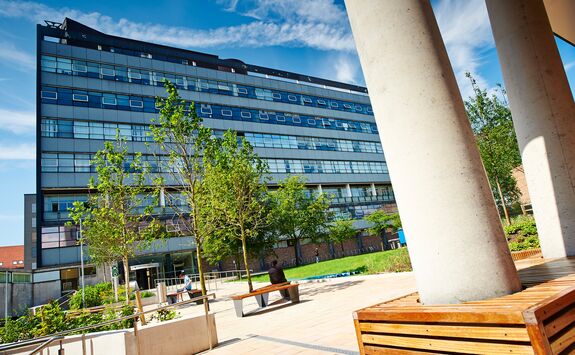
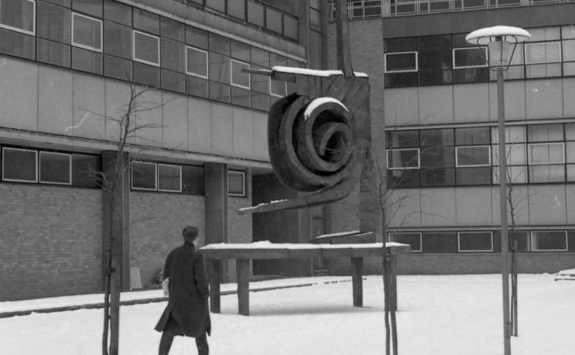
Marjorie Robinson Library Rooms
The Marjorie Robinson Library Rooms opened in January 2016, named after university benefactor Marjorie Robinson. Upon her death in 1998, Marjorie left an £8 million bequest in her will to the university’s library. Her donation remains the largest to a UK university library ever.
Both Marjorie and her husband Philip (pictured) were supporters of the university and Friends of the Library, with the main university on campus being named the Robinson Library from 1989 to 2016 (when it was renamed the Philip Robinson Library to distinguish it from the new Marjorie Robinson Library Rooms). The two facilities are affectionately known as the Robbo and the Marj by our student community.
A digital library, the Marjorie Robinson Library Rooms house a variety of innovative digital learning spaces and for two years, housed research group Open Lab on its top two floors.
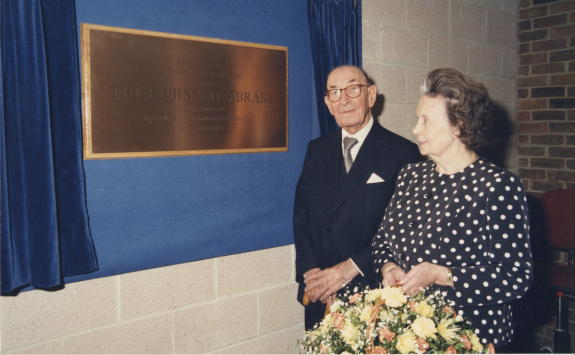
Walton Library
The Walton Library is the faculty library for Medical Sciences and is located on the 5th Floor of the Catherine Cookson Building. It serves the Schools of Medicine, Dentistry, Psychology and Biomedical Sciences as well as the Graduate School and Research Institutes of the Faculty, and is named after Lord John Walton (1922 – 2016), former Dean of Medicine at the University and renowned neurologist.
Lord Walton qualified from Durham University College of Medicine and completed his MD at Newcastle Medical School. He was a medical pioneer in muscular dystrophy and throughout his career, he was President of the British Medical Association (1980 to 1982), General Medical Council (1982-89) and the Royal Society of Medicine (1984 to 1986). Alongside the library, his esteemed research and career were recognised in 2014 with the creation of the John Walton Muscular Dystrophy Research Centre at Newcastle University, which supports world-leading research in this field.
Lord Walton is the longest-serving Dean of Newcastle Medical School in its history, and after his retirement remained a staunch supporter of the Medical School and its activities, most notably through his position in the House of Lords. He also played a significant role in Newcastle University getting General Medical Council approval for our Medical School in Malaysia and parliamentary approval of our mitochondrial work.
